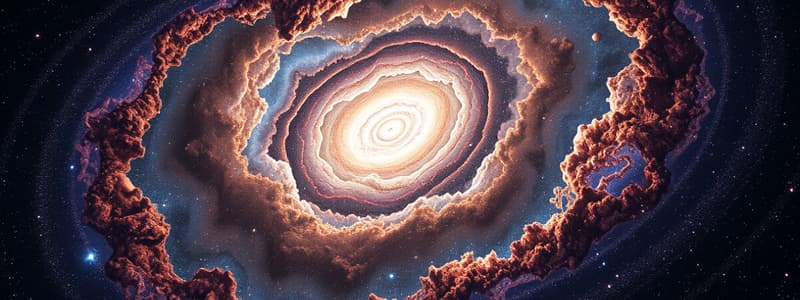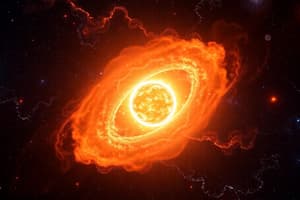Podcast
Questions and Answers
What is the closest spiral galaxy to the Milky Way?
What is the closest spiral galaxy to the Milky Way?
What do you think is the estimated age of the universe?
What do you think is the estimated age of the universe?
What is a hypothesis?
What is a hypothesis?
An assumption or idea proposed for testing.
What is a theory?
What is a theory?
What percentage of the universe is made of baryonic matter?
What percentage of the universe is made of baryonic matter?
What are the three most abundant elements in the universe?
What are the three most abundant elements in the universe?
What is the Big Bang Theory?
What is the Big Bang Theory?
The diameter of the universe is finite.
The diameter of the universe is finite.
Who was the first proponent of the Big Bang Theory?
Who was the first proponent of the Big Bang Theory?
Which of the following theories proposes that the universe expands and new galaxies are formed continuously?
Which of the following theories proposes that the universe expands and new galaxies are formed continuously?
This theory suggests that the solar system formed after a star passed near the Sun: _________
This theory suggests that the solar system formed after a star passed near the Sun: _________
According to the Nebular Theory, what comprises a nebula?
According to the Nebular Theory, what comprises a nebula?
Which of the following is not a member of our solar system?
Which of the following is not a member of our solar system?
Who among the following theorists suggested the Protoplanet Theory?
Who among the following theorists suggested the Protoplanet Theory?
Flashcards are hidden until you start studying
Study Notes
Origin of the Universe
- Closest spiral galaxy to the Milky Way is the Andromeda Galaxy.
- Estimated age of the universe is approximately 13.8 billion years.
Key Concepts
- Hypothesis: An assumption for argument testing.
- Theory: A system that describes, explains, and predicts real-world phenomena based on substantiated data.
Structure, Composition, and Age
- Universe composition: 4.6% baryonic matter, 24% cold dark matter, 71.4% dark energy.
- Most abundant elements: Hydrogen, Helium, Lithium.
- Stars are born from clouds of gas and dust; protostars represent early star formation.
Big Bang Theory
- Cosmological model explaining universe expansion from approximately 13.8 billion years ago.
- Universe began as a singularity with extremely high temperature and density; transition formed matter and antimatter.
Nucleosynthesis
- Formation of light elements (H, He) shortly after the Big Bang led to the creation of stars and galaxies.
Evidence for Big Bang Theory
- Observational evidence shows galaxies receding, supporting universe expansion.
- High quantities of light elements formed through fusion post-Big Bang.
- Cosmic Microwave Background (CMB) radiation detected as remnants of the Big Bang.
Proponents of Big Bang Theory
- Georges Henri Joseph Edouard Lemaître: Proposed the expanding universe.
- Edwin Powell Hubble: Established Hubble's Law, indicating galaxies are not static.
Drawbacks of the Big Bang Theory
- Does not explain how the universe was created, only its evolution.
- Lacks clarity on the formation of galaxies.
Steady State Theory
- Proposes a continuously expanding universe with constant average density.
- Suggests new matter is created as old stars and galaxies become unobservable due to increasing distance.
Proponents of Steady State Theory
- Hermann Bondi, Thomas Gold, Fred Hoyle: Introduced this view in 1948.
Oscillating Universe Theory
- Suggests the universe expands and contracts repeatedly, leading to “big bounce” scenarios.
- Proposed by Richard Tolman, implying a cyclic universe model.
Drawbacks of Oscillating Theory
- Collapsing universe scenario contradicts current physics laws and theories regarding dark energy.
Nebular Theory
- Solar system formed from a nebula approximately 4.5 billion years ago, a massive cloud of gas and dust.
- Nebula primarily consists of hydrogen, helium, and other gases.
Major Steps in Solar System Formation
- Cloud Collapse: Initiates the process.
- Formation of Protoplanetary Disk: Dust and gas begin to coalesce.
- Growth of Planets: Formation of terrestrial and jovian planets.
Types of Planets
- Terrestrial Planets: Mercury, Venus, Earth, Mars formed from denser materials near the Sun.
- Jovian Planets: Jupiter, Saturn, Uranus, Neptune formed farther from the Sun with cooler temperatures, allowing gas condensation.
Encounter Theory
- Proposes planets formed from material ejected from the Sun during encounters with other celestial bodies.
Protoplanet Hypothesis
- A modified version of the nebular theory, associated with theorists Carl von Weizsäcker and Gerard Kuiper.
Quiz Questions
- Questions encourage review of theories, nebula composition, members of the solar system, and notable theorists.
Assignment Prompt
- Explore the fate of the universe: Whether it will continue expanding or eventually contract under gravitational forces.
Studying That Suits You
Use AI to generate personalized quizzes and flashcards to suit your learning preferences.




